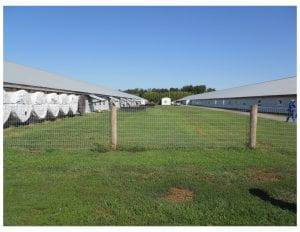On September 16, 2019 Mr. Ed KEE spoke to us on Delaware Agriculture and it’s importance as a feed shed. The talk began with a bit of bio provided by both Prof. ISAACS and Mr. KEE, who shared a brief synopsis of his education and his ties to the University of Delaware’s continued work in the advancement of modern agriculture. He stated that although UD became a land grant college in 1869, it wasn’t until the 1990s, when Dean Harry HAYWARD initiates the university’s purchase of $20, 000 worth of campus-adjacent farmland, that the Agricultural department started to make great strides- with the help of Dr. Bill MITCHELL, a WW2 veteran and extension agronomist.
Mr. KEE’s eight year tenure as Delaware’s Secretary of Agriculture, and two published works on the history of UD’s Agricultural Extension and Carvel Research Center, meant he had the background to give the class an in-depth picture of Delaware farming from the Colonial Days to today- including an interesting a related anecdote into Prof. ISAACS’ ancestry to illustrate the tenacity and determination required of farmers.
From the Revolutionary War to the early 1800s Delaware primarily exported wheat. After the completion of the DE Railroad in 1859 and the DuPont Highway in 1924 Delaware is able to improve the ways in which food is transported, shipping produce as canned goods in water or brine. Many canneries are built around Delaware to process vegetables and fruits like tomatoes, peaches, and strawberries, but also ‘fruits of the sea’ like oysters, employing many individuals to move shipments from one point to another. One cannery, the Stokely-Van Camp Cannery, was an early example of early agribusiness and the thought process behind environmental accountably. The cannery, and other processors like it, would discard bean husks and effluent directly into the canals and waterways they were built near, clogging and polluting the watershed with excess nutrients and detritus. This myriad number of canneries, mills, and factories would decrease from hundreds, to a mere two that remain today- PicSweet and Hanover- large companies that bought up smaller ones for better brand recognition.
The processors of the early 1900s did well, but the farms that provided them with product were rarely operating at peak efficiency. Mr. KEE, citing Prof. ISAACS family line as an example, stated that most small farmers before WW2 would barely eke out 30 bushels of corn year after year, only just making a profit, but continuing to grow anyway. It wasn’t until after WW2, when farmers embraced new technologies such as Henry WALLACE’s Pioneer Seed Co. seed stock and hybrid varieties, that they were able to increase their yield to 80 bushels. Similar scientific advancements occurred with poultry, dairy, and other forms of produce.
The increasingly high yields and technological advancements in agriculture have made the farming field one that requires a consistent, regulatory environment to turn a profit. Through increased education, business procedures and regulations, farming has improved not only for the farmer, but also the consumer.
As stated by former Guest Speaker Ms. Georgie CARTANZA and Professor ISAACS, Delaware’s unique geographic position places most of it’s farms within eight hours driving distance to 1.1 million people, or 1/3 of the U.S. population. 76% of the state is open space, with ≈2/3 of that amount dedicated to farmland- ≈800 farms. Of the 41% of the land area dedicated to farms- a total of 115, 000 acres- a total of ≈30% is permanently reserved through the AgLand Preservation Program, which was established in 1995. The AgLand Preservation Program is a core feature of Delaware’s Agricultural economy, providing a steady and reliable market for farmers. Through the AgLand program, land can be given to the state for preservation in perpetuity, or sold by the farmer to another farmer so the property remains apart of the Agricultural System.
Another program Mr. KEE shared with the class was the Young Farmers Program. Mr. KEE haunted earlier that many farms are small farms of about 30-50acres. Unable to compete with the ‘Big Ag’ industry for a larger share of the profits, about 40% of those farmers have off-farm income generated from other jobs such as teaching, factory work, or school bus driving. The Young Farmers Program provides $500, 000 for a qualified young farmer at 0% interest for 30years.
In order to help farmers young and old, make larger profits, many states have increased efforts to educate the public on farming as well. Unlike the post-WW2 farmers, many modern-day consumers tend to be resistant to the innovations made in farming. State Universities like UD try to educate to public on current farming practices. Such practices discussed in class included Integrated Pest Management, used to identify and target specific pest to employ a targeted and controlled response that generates as little perceived amount of environmental harm possible; the use of Center-Pivot Irrigation Systems, irrigation that can be moved and monitored remotely via a cell phone for the optimum application of water. Many more practices went unmentioned due to time constraints, but the need for greater public education regarding agriculture was greatly emphasized.
The lecture closed with a discussion on the cultivation of hemp and the controversies surrounding a potential future cash crop. Hemp might be harvested for CBD oil or fibers, though its legality is still not consistent across the U.S.- particularly by the FDA as food additive. With and uncertain future and an unidentified market, many farmers might embrace the crop from and ethical standpoint, but can’t financially absorb the costs to grow it without a guaranteed profit. Mr. KEE spoke of a group of Hollywood investors that approach a family farm of several generations to grow 1000 acres of hemp for them to process and ship. The farmers agree to take the risk, but only if they were paid upfront. The anecdote served to illustrate the balance between farmers and consumers, and how consumer demand and existing markets play a critical role is what is produced and how much.


















